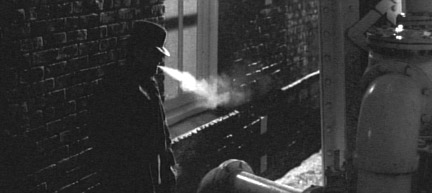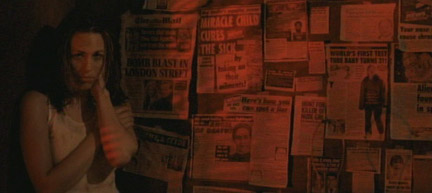
As many people pointed out to me when told of what I was planning - adapting a poem is no easy task. The pure nature of poetry lends itself to infinite interpretations. For me, however, King's prose was pretty clear from the first line. As with all of King's writing, his characters are so well constructed that they (excuse the cliché) leap off the page.
One of the first decisions I made had to do with casting a woman as opposed to a man. For some bizarre reason - blame it on society, if you must - reading through this prose one immediately conjures up the idea that we're hearing the torments of a man. Perhaps it's because we have - for the most part, don't crucify me here - an image of women as being demure, delicate, beautiful and not in the least bit capable of being totally and completely out of their gourd. One of the first thoughts that came to me was - let's turn this on its side and cast a woman. I carefully scoured through the text to see if there were any indicators as to the sex of the character - and nope, there were none. SO! Bingo, we've got a psycho-chick in our midst.

Next up was to carefully break down the poem element by element and find the images in King's prose. He makes this pretty easy with elements like: "Their eyes are silver dollars..." and "His cigarette winks from just above his trenchcoat collar" - these lines immediately draw images to mind. Working off the idea of paranoid schizophrenia being a state of a split mind (see psychology and research section), I wanted to have a way of visually separating her delusions from what is real. Furthermore, I wanted to separate her delusions as being completely outside of her refuge. The first step was to place everything that is imagined in black and white and outside of her hotel room. These moments I translated fairly literally from the prose - "There's a man by the door, smoking a cigarette" - and boom, we cut to (can ya guess? Are you with me Boys and Girls?) a man outside smoking a cigarette (see, now that's not rocket science is it?). I kept a little more loose with my visual linkages to the prose when we were in her reality - inside her hotel room where we get to see her for what she really is: an extraordinarily disturbed woman.
Probably most important of all - and I've talked about this before, and I'll talk about it again and again - was keeping to King's prose. The very structure of the way the text lays out on the page dictated the pacing of the whole film. When he breaks a paragraph, the film will visually, aurally, or both, take a break a well. We go into blackness only in paragraph breaks - the way the key statement:
is laid out on the page dictated the jump-cut sequence that feels something like this:
There is a definite cadence that King creates in the structure of the poem
and although I wasn't savvy enough to be able to label it iambic pentameter
or the like - I did what I could to have that rhythm in my mind at all stages
of the game. There were also clues in his use of punctuation - a hyphen is
very different from a comma or a period. All of that played an important
role in how I interpreted the poem.
Conceptualizing and understanding the Woman was probably the most challenging
part. The prose takes us through many different emotions and states of mind
where she is passive/aggressive sometimes feeling the victor - sometimes
the victim. When Tonya and I went to work in rehearsals, we fine-tuned this
to be that she is always the victim. She is always the weaker one, even though
she has moments of false bravado -
But it's empty threats. She doesn't have the strength to back any of it
up. Perhaps she once did - but after God knows how long she's been in this
torment - she doesn't any longer.
I looked at a number of films before I shot Paranoid, namely Adrian
Lyne's Jacob's Ladder and David Fincher's Seven, both of which
have extraordinary ambience and mood. As much as some people have compared
Paranoid to David Lynch's films, I've got to say that I'm not a fan
of his work, it doesn't appeal to me and I can't say that I drew from any
of his films as inspiration for this one. I did, however, draw inspiration
from Angelo Badalamenti, a composer who has often collaborated with Lynch,
when it came time to work with Buck Sanders on the score (see
sound
and score section).
Visually speaking, I made the decision to shoot the film in "widescreen"
2.35:1 aspect ratio to accentuate the alienation of the woman in nearly every
frame. I wanted the compositions to be aggressive - forcing her into the
edge of an empty frame, visually keeping her in the corner no matter where
she was. I also chose a limited, nearly monochromatic color palette (see
production
design section) that further removed her from the normal world. Listen -
listen
do listen:
you must listen.




You may think you have me but I could destroy you
any second now.
Any second now.
Any second now.

I went back and forth on the concept of camera movement in the film.
Originally, I wanted the camera to be nearly constantly moving, always presenting
an energy as frenetic as her mind, but something about that didn't sit right
with me. The flip side was to contrast her mental state and shoot the entire
film in lock-offs where everything is rigid and not allow any camera movements.
Although I worked in more of a hybrid between the two concepts, I did stick
a little stronger to the latter thought process because it seemed to serve
the story better, and - technically speaking - we didn't have the time or
the appropriate equipment to really do the movement the way I wanted. We
did build a fair amount of "movement" into the film in the pacing of the
editing - especially at the final climax of the film during her "any second
now" section (see
editing
section).
As you'll see from looking at these conceptual notes, the research notes,
and the script excerpts, I tend to be extraordinarily detailed in my thought
process in pre-production. Especially with a film like Paranoid when we only
have a day to shoot it. But once I start shooting - I very rarely will refer
back to my notes. My general process is to do as much homework as I possibly
can before the filming begins and then let it all go. If I've done the job
right, all of that homework will be ingrained in my mind and will color my
instincts on set to lead me into the right direction. I don't want to be
locked down to exactly what I thought we should do in pre-production - I
want to allow room for improvisation and discovery on the set and as a result,
the research and notes that I make in pre-production, more often than not,
stay in pre-production.